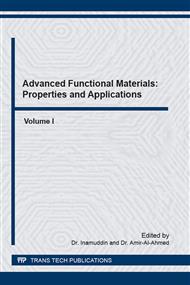[1]
T. Hata, K. Umemura, H. Yamauchi, A. Nakayama, S. Kawai, H. Sasaki, Design and Pilot Production of a Spiral-Winder, for the Manufacture of Cylindrical Laminated Veneer Lumber, J. Wood Science 47(2) (2001) 115-123.
DOI: 10.1007/bf00780559
Google Scholar
[2]
B. Uysal, Bonding Strength and Dimensional Stability of Laminated Veneer Lumbers Manufactured by Using Different Adhesives After the Steam Test, Int. J. Adhes. Adhes. 25(5) (2005) 395-403.
DOI: 10.1016/j.ijadhadh.2004.11.005
Google Scholar
[3]
I. Aydin, S. Colak, G. Colakoglu, E. Salih, A Comparative Study on Some Physical and Mechanical Properties of Laminated Veneer Lumber (LVL) Produced from Beech (Fagus orientalis Lipsky) and Eucalyptus (Eucalyptus camaldulensis Dehn. ) Veneer. Holz als Roh- und Werkstoff 62(3) (2004).
DOI: 10.1007/s00107-004-0464-3
Google Scholar
[4]
Z.H. Wu, T. Furuno, B.Y. Zhang, Properties of Curved Laminated Veneer Lumber Made From Fast-Growing Species with Radiofrequency Heating for Use in Furniture, J. Wood Science 44(4) (1998) 275-281.
DOI: 10.1007/bf00581307
Google Scholar
[5]
C. Tenorio, R. Moya, F. Munoz, Comparative Study on Physical and Mechanical Properties of Laminated Veneer Lumber and Plywood Panels Made of Wood from Fast-Growing Gmelina arborea Trees, J. of Wood Science 57(2) (2011) 134-139.
DOI: 10.1007/s10086-010-1149-7
Google Scholar
[6]
R. Hashim, S.N. Sarmin, O. Sulaiman, L.H.M. Yusof, Effects of Cold Setting Adhesives on Properties of Laminated Veneer Lumber from Oil Palm Trunks in Comparison with Rubberwood. Eur. J. Wood Wood Prod. 69(1) (2009) 53-61.
DOI: 10.1007/s00107-009-0405-2
Google Scholar
[7]
J.L. Bowyer, R. Shmulsky, J.G. Haygreen, Forest Products and Wood Science – An Introduction: Fourth Edition. A Blackwell Publishing Company, United States of America (2003).
Google Scholar
[8]
F. de Souza, C.H.S. del Menezzi, G.B. Junior, Material Properties and Nondestructive Evaluation of Laminated Veneer Lumber (LVL) Made From Pinus oocarpa and P. Kesiya, Eur. J. Wood Wood Prod. 69(2) (2010) 183-192.
DOI: 10.1007/s00107-010-0415-0
Google Scholar
[9]
S. Hiziroglu, Laminated Veneer Lumber (LVL) as a Construction Material, Food Technology Fact Sheet 163 (2009) 1-4.
Google Scholar
[10]
S.R. Shukla, D.P. Kamdem, Properties of Laboratory Made Yellow Poplar (Liriodendron tulipifera) Laminated Veneer Lumber: Effect of the Adhesives, Eur. J. Wood Wood Prod. 67(4) (2009) 397-405.
DOI: 10.1007/s00107-009-0333-1
Google Scholar
[11]
S.C. Oh, Applying Failure Criteria to the Strength Evaluation of 3-ply Laminated Veneer Lumber According to Grain Direction by Uniaxial Tension Test. Constr. Build. Mater. 25(3) (2011) 1480-1484.
DOI: 10.1016/j.conbuildmat.2010.08.002
Google Scholar
[12]
K.R. Bootle, Wood in Australia – Types, Properties and Uses: Second Edition. McGraw Hill, Australia (2005).
Google Scholar
[13]
B. Ozarska, A Review of the Utilisation of Hardwoods for LVL, Wood Sci. Technol. 33(4) (1999) 341-351.
DOI: 10.1007/s002260050120
Google Scholar
[14]
P. Lu, W.J. Muller, E.K. Chacko, Spatial Variations in Xylem Sap Flux Density in the Trunk of Orchard-Grown, Mature Mango Trees Under Changing Soil Water Conditions, Tree Physiol. 20(10) (2000) 683-692.
DOI: 10.1093/treephys/20.10.683
Google Scholar
[15]
S. Colak, G. Colakoglu, I. Aydin, Effects of Logs Steaming, Veneer Drying and Aging on the Mechanical Properties of Laminated Veneer Lumber (LVL), Build. Environ. 42(1) (2007) 93-98.
DOI: 10.1016/j.buildenv.2005.08.008
Google Scholar
[16]
I.S.E. Bally, Species Profiles for Pacific Island Agroforestry: Mangifera indica (mango). Ver 3. 1 (2006). (http: /www. kammika. com/woodinfopictures/Mangifera-mango. pdf).
Google Scholar
[17]
P.S. H'ng, M.T. Paridah, Bending Properties of Laminated Veneer Lumber: Effect of Keruing (Dipterocarpus spp. ) Reinforcement and Cyclic-Boil-Dry-Treatment. XII World Forestry Congress. Quebec City, Canada (2003).
DOI: 10.3923/ajsr.2010.118.125
Google Scholar
[18]
K.C. Rajendra, Determination of Tensile Shear Strength in Scot Pine. 1 (2007) 1-6.
Google Scholar


